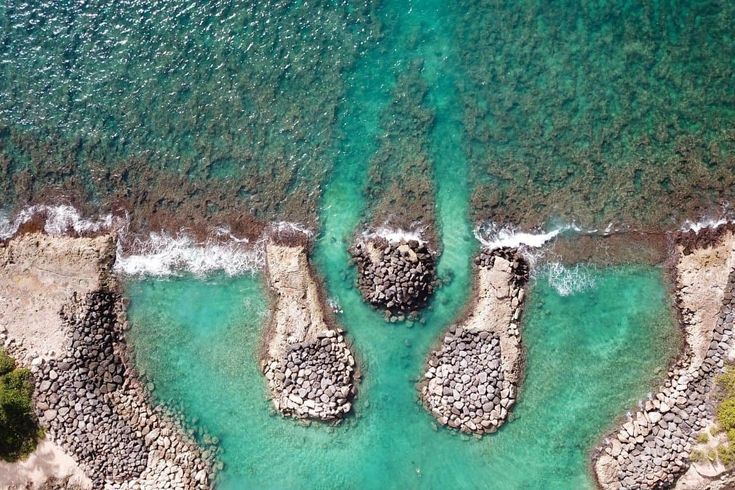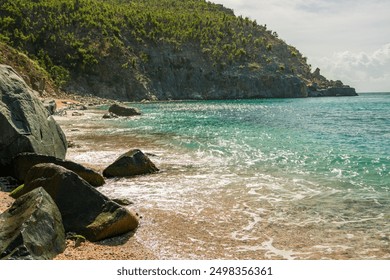Turn Vacation into Education: Unique Beaches as Outdoor Classrooms

Imagine a vacation where your children aren't just building sandcastles, but also building a lifelong love for science and the natural world. For affluent families with children aged 5-12, the world's unique beaches offer incredible opportunities for outdoor learning, turning family trips into immersive educational experiences. Ditch the textbooks and embrace the wonders of marine biology, geology, and conservation with your children as you explore the pristine shores of Ko Olina Lagoons, Trunk Bay, and Shell Beach.
Ko Olina Lagoons: A Gentle Introduction to Marine Life
The calm, crystal-clear waters of Ko Olina Lagoons in Oahu, Hawaii, provide the perfect setting for children to dip their toes into the world of marine biology. These man-made lagoons are sheltered from the open ocean, creating a safe and tranquil environment for young children to learn to snorkel. The gentle waves and shallow depths allow even the most hesitant beginners to feel comfortable exploring the underwater world.
As your children snorkel, they'll be able to observe a variety of colorful fish, playful sea turtles, and other fascinating marine creatures. Encourage them to keep a lookout for the Hawaiian state fish, the humuhumunukunukuāpuaʻa, a reef triggerfish with a name that’s as memorable as its appearance.
For an even richer experience, consider staying at the Aulani, a Disney Resort & Spa. Aulani offers a range of family-friendly marine conservation programs, where children can learn about Hawaiian marine life, participate in conservation efforts, and even interact with marine experts. This provides an engaging and memorable opportunity to learn about marine conservation and the importance of protecting our oceans.
Educational Activities in Ko Olina
- Lagoon Exploration: Spend a day exploring the different lagoons, noting the unique features of each and the types of marine life you encounter.
- Aulani's Conservation Programs: Take advantage of Aulani's educational programs to learn about Hawaiian marine life and conservation efforts.
- Family Travel Journal: Encourage your children to sketch and take notes about the marine life they observe.
Trunk Bay: A Snorkeling Adventure on a Marked Trail
Trunk Bay in St. John, US Virgin Islands, is renowned for its stunning beauty and its incredible snorkeling opportunities. What makes Trunk Bay particularly special for families is its self-guided snorkeling trail, a marked underwater path that leads snorkelers through a vibrant coral reef ecosystem. This location is a great example of eco-tourism.
The snorkeling trail features underwater signs that provide information about the different species of coral and marine life you'll encounter. For example, one sign might explain the importance of elkhorn coral and its role in providing habitat for other marine organisms. Another sign might help you identify different types of fish, such as the parrotfish or the blue tang.

To enhance your child's learning experience, consider participating in the Virgin Islands National Park Junior Ranger program. This program offers a range of activities and educational materials that will help your children learn about the natural and cultural history of the Virgin Islands. Virgin Islands National Park Junior Ranger program The program is free and open to children of all ages, and it's a great way to make your visit to Trunk Bay even more meaningful. Find out more about the Trunk Bay Snorkeling Trail.
Educational Activities in Trunk Bay
- Snorkeling Trail Scavenger Hunt: Create a scavenger hunt list based on the underwater signs, challenging your children to find specific species of coral and marine life.
- Junior Ranger Program: Participate in the Virgin Islands National Park Junior Ranger program to learn about the natural and cultural history of the islands.
- Marine Life Identification: Use field guides to identify the different species of fish and coral you encounter.
Shell Beach: A Geological Wonder
Shell Beach in St. Barthélemy is a unique and fascinating destination that offers a different kind of educational experience. Unlike most beaches, Shell Beach is not made of sand, but rather of millions of tiny shells. These shells are the remnants of marine organisms that have been eroded by the sea over time. This is a perfect location for geology field trips for families.
The geological process that created Shell Beach is a testament to the power of nature and the constant cycle of erosion and renewal. As you walk along the beach, encourage your children to collect and examine the different types of shells. Use field guides to identify the various species of mollusks and other marine organisms that once inhabited these shells.

To further enhance your understanding of the geological processes that created Shell Beach, consider visiting the nearby Marine Park. The Marine Park offers educational programs about shell formation and the ecology of the surrounding waters. The Marine Park also does a great job with marine conservation.
Educational Activities in Shell Beach
- Shell Identification: Use field guides to identify the different types of shells found on Shell Beach.
- Geological Exploration: Discuss the geological processes that created Shell Beach, such as erosion and sedimentation.
- Marine Park Visit: Visit the nearby Marine Park to learn about shell formation and the ecology of the surrounding waters.
Enhancing the Learning Experience
No matter which beach you choose, there are several ways to enhance the educational experience for your children:
- Create a Family Travel Journal: Encourage your children to keep a travel journal with sketches, notes, and observations about the marine life, geological formations, and conservation efforts they encounter.
- Participate in Beach Cleanups: Organize or join a beach cleanup and document your findings. This is a tangible way to teach children about the impact of pollution on marine ecosystems.
- Examine Sand Samples: Use kid-friendly microscopes to examine sand samples from different beaches. This will allow your children to see the unique composition of each beach and identify different types of sand grains.
- Use Educational Apps: Augment your learning experience with educational apps like Seek by iNaturalist (for identifying plants and animals) or PictureThis (for identifying plants).
- Review Educational YouTube Playlists: Pre-plan educational YouTube playlists to review after returning home. Channels like National Geographic Kids offer a wealth of engaging and informative content.
By turning your vacation into an outdoor classroom, you can spark your children's curiosity, foster a love for science, and create memories that will last a lifetime. Vistalocation.com offers a range of educational travel packages and accommodations that cater to children's needs. Explore our website today to plan your next adventure and turn vacation into education! Book now & save.